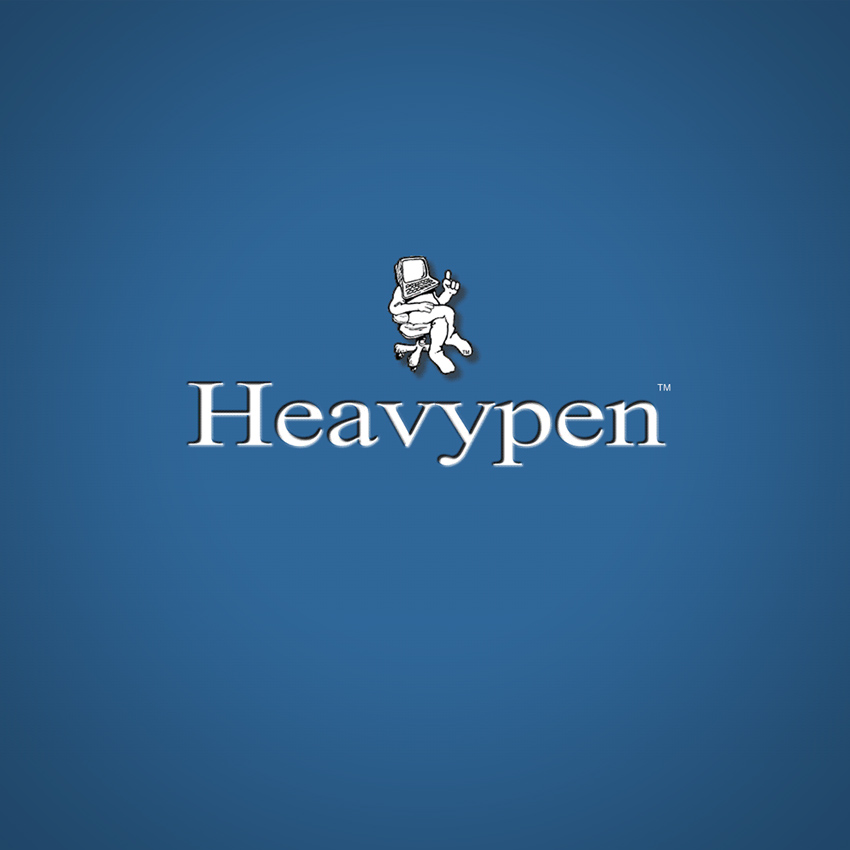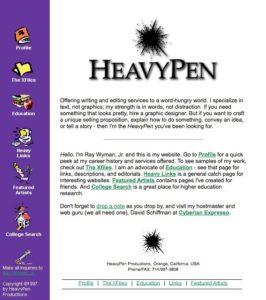
Very Heavy – Since 1997
My journey began with this website.

Heavypen.com was my first website. I launched it in 1997. The pic on the right is as the site looked around at that time. Actually, this was the second design version, aided by some early Microsoft HTML design helpers. The first version was hard-coded from scratch with Notepad using HTML Reference and HTML Advanced Reference manuals that were written and published by James Armstrong based in Seattle, WA. The original version is lost forever – but you can see various iterations of the site through the Wayback Machine.
Long story – hard coding was an enormous pain in the butt. The version in the image above was created using Microsoft Publisher using the built-in website conversion process, which was another kind of pain. I used DreamWeaver for a while – and learned about REAL code bloat. I eventually discovered Noah Grey and his Greymatter blogging software (a precursor of WordPress). Eventually, Greymatter evolved into WordPress, with prettied templates and much better media handling.
Through all that experimentation, I learned several valuable lessons about the ‘all-important’ page presentation, navigation, and overall site design. I can’t say that I practice all the ‘best practices’ on my own website. Heavypen is a bit of a laboratory: I test ideas here. I frequently break software and crash this site with new templates, plugins, and widgets.
Which brings me to WHY we have websites in the first place. For me, it started as part of a learning curve. Back in the late 90s, we had some pretty lofty ideas about what the Internet would do for us. It took almost 10 years for people to figure out how it would work.
Speaking of the 90s, There was a meme about people who thought, “build it, and people will come.” That’s one of the ideas that didn’t work out so well. It’s okay if you see your website as a destination. But don’t forget the means of travel. We discovered that even an ‘information superhighway’ needs an offramp.
Your target audience — people who have never heard of you or your brand — they may find your website by luck. But it’s more likely that they’ll find you through some other means like social media or person-to-person (e.g., referral). And what about the primary purpose of your website? It could be the best ‘leave-behind’ brochure you could ever possibly make, especially if it has the exact content needed to convince the people you want to talk to. A website should do at least two things:
- Encourage engagement: tell a story about something you can do or something you build that other people need to know more about.
- Instigate Interaction: Give people a reason to keep visiting your site, but build up expectations to a point where people WANT to reach out.
It cost people a ton of money just to figure out those two points I just tossed off. Excite.com, one of my earliest consulting gigs in SEO and SERP planning (we didn’t call it that back then), launched with more than $150M on the notion that they would build a destination. People from all around the world would come to be excited because, well, THE WEBSITE was exciting! No kidding. I sat through several meetings where the leader of the marketing team who tried to “Steve Jobs” us into believing that the LOGO and site functionality was our whole reason for existence. Less than two years later, the marketing operation shut down. A year after that, the property began a journey that took it from one investment holding company to another as a total loss.
We can learn from success, but we learn so much more from failure, don’t you think?
For instance, imagine how many failures like Excite.com it took for people to realize that MOST people come to websites because they’re looking for other people to help them decide something. Therefore, the best way to bring people to a website is to make it easier to find by people who are actively searching. That’s a bit trickier to do than to say. It requires a bit more front-end work and lots of long-term planning. This blog post may be an example. If you are reading this, you may have stumbled upon me via a general search like “freelance content creator,” or “SEO SERP strategies.” Or, maybe it was through a chain of events, starting with a social media post on LinkedIn, a link to an article about content creation, then here. If you’re like most searchers, you’re doing your due diligence to see if I am a good fit for what you have in mind. See what I did there?
There are a lot of reasons to build a website, but it takes a bit of planning and forethought to make one that helps you achieve goals. Your website can even be the doorway to customer engagement and interaction. But the bigger your plans, the more long-term strategy is required, and the bigger your vision should be.
Mine began in 1997. Yours can start today.
About: Ray Wyman, Jr is a content creator, communications professional, and author with more than 30 years of experience. Visit LinkedIN or Raywyman.com for more information.


